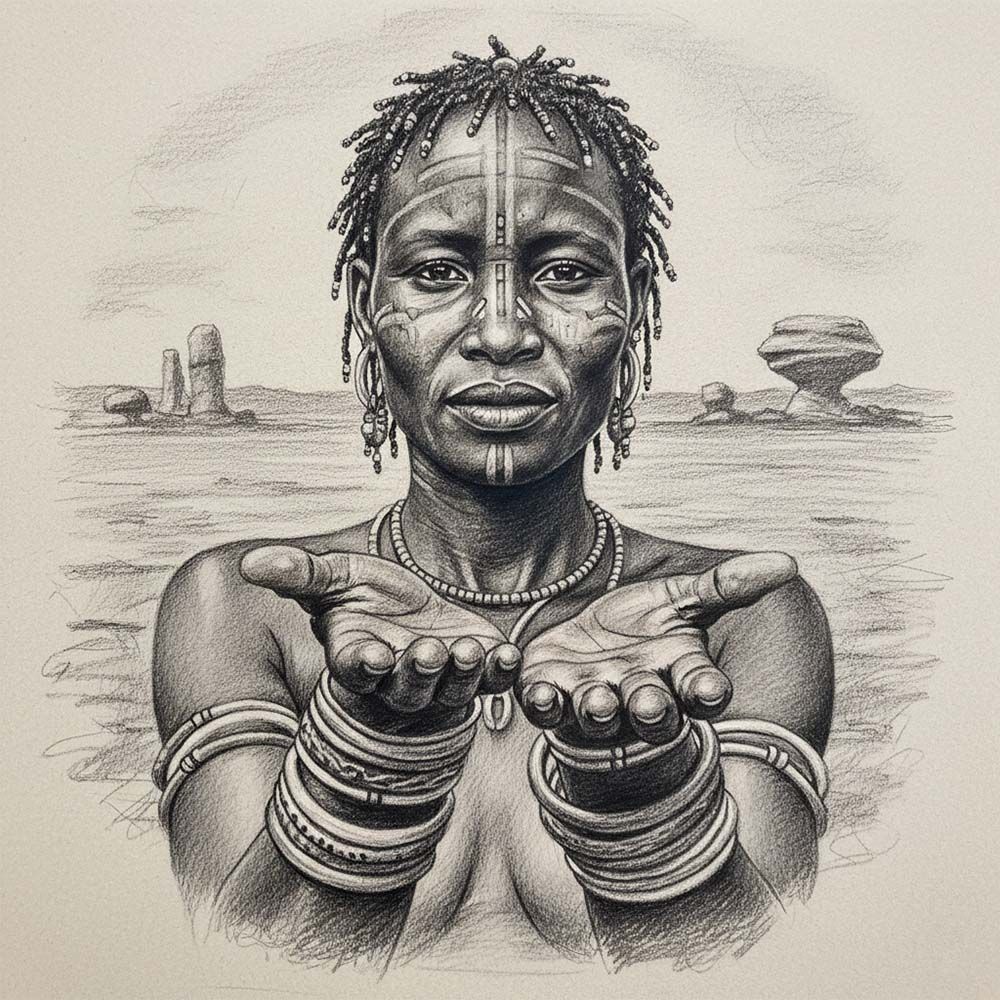
Traditional Practice in the Grasslands
A cultural image showing a Khoisan woman seated quietly in a grass field. The scene symbolizes traditional practices such as manual labia stretching once taught privately within Khoisan communities, highlighting the link between cultural identity, environment, and women’s traditional knowledge.
Tradition, Method, and Meaning
Manual Labia Stretching: Understanding Practice, Purpose, and Cultural Meaning
Manual labia stretching is a traditional and contemporary body practice that involves the gentle and gradual elongation of the labia minora using the hands. While it remains unfamiliar to many outside specific regions, the practice has a long-standing cultural presence in certain African societies and has recently become a subject of renewed curiosity and research worldwide. This article examines what manual labia stretching is, how it is practiced, its cultural background, and what modern science and health professionals say about it—all within an educational and neutral context.
What Manual Labia Stretching Involves
Manual labia stretching typically refers to the process of slowly and consistently pulling or massaging the inner labia (labia minora) to increase their length over time. It is generally done by the individual herself, though in some cultural settings, elder women or peers traditionally guide younger women through the process.
The stretching can be done daily or several times a week. Gentle pulling using the fingers, along with the application of natural oils or lubricants, is common. The practice does not involve cutting, piercing, or any form of tissue removal—distinguishing it clearly from forms of genital mutilation.
Most practitioners emphasize patience, hygiene, and comfort. The degree of stretching and the desired length vary widely, and many stop once they feel a personal sense of completion or comfort with the outcome.
Cultural Context and Traditions
Historical and anthropological studies indicate that manual labia stretching has deep cultural roots in several parts of sub-Saharan Africa, including Uganda, Rwanda, Malawi, and Zambia. In these regions, it has been passed down through generations as part of traditional education for adolescent girls.
Elders or older women, often within initiation ceremonies or private mentorship, introduce the practice as part of preparation for womanhood, intimacy, and marriage. It is sometimes described as a symbol of maturity, beauty, or readiness for partnership.
In Rwandan and Ugandan traditions, for example, elongated labia are occasionally associated with increased sexual pleasure for both partners, and the practice can carry social esteem. However, not all individuals from these regions participate, and perceptions vary—some see it as cultural heritage, while others consider it a personal or outdated custom.
With migration and globalization, manual labia stretching has gained attention in the wider world. Discussions about it now appear in medical journals, academic research, and online communities. In these modern contexts, the practice is often reframed as a form of body modification or personal choice rather than a strictly cultural expectation.
Contemporary Perspectives and Health Considerations
Modern medical perspectives on labia stretching are evolving. Researchers and clinicians generally agree that, when done carefully and hygienically, the practice poses minimal health risks. Studies suggest that gradual stretching using lubricants or oils can be performed safely if infections are prevented and the tissue is not overstressed.
Potential risks arise when hygiene is poor, when excessive force is applied, or when non-sterile objects are used. Pain, tearing, and infection can occur if the practice is done improperly. For this reason, health professionals emphasize cleanliness, awareness of anatomy, and self-consent as essential components.
It’s also worth noting that there is no universal medical benefit associated with the practice. While some individuals report increased sexual satisfaction or comfort with their bodies, others see no physical advantage. The results—both aesthetic and sensory—are highly subjective.
How It Is Practiced Today
In regions where it remains part of traditional teachings, manual labia stretching is often introduced in adolescence, with guidance emphasizing patience and respect for the body.
Outside of these traditional contexts, adults who explore labia stretching today often do so privately, guided by online information or body-modification communities. Common methods include:
-
Preparation: Washing hands thoroughly and cleaning the genital area.
-
Lubrication: Applying natural oils (such as coconut or olive oil) or a water-based lubricant.
-
Technique: Gently pulling the inner labia outward using the fingers for a few minutes at a time.
-
Consistency: Repeating the process regularly—sometimes daily or weekly.
-
Comfort: Stopping immediately if pain, discomfort, or irritation occurs.
Stretching progress varies from person to person, depending on factors such as natural elasticity, frequency, and technique. Some individuals practice for cultural continuity, others for aesthetic preference, and some out of curiosity.
Shifting Meanings and Body Autonomy
In modern conversations about body image and cultural identity, manual labia stretching represents an interesting intersection of tradition, autonomy, and changing norms. For some, it is a valued expression of heritage; for others, it’s a personal exploration of anatomy and sensuality.
In postcolonial academic discourse, researchers have noted that Western perspectives historically misunderstood or stigmatized the practice, often labeling it under broader categories of genital modification without distinguishing its voluntary and non-harmful aspects. Recent scholarship, however, takes a more nuanced view, recognizing that cultural and personal body practices cannot be easily categorized as “right” or “wrong” without context.
Ethical and Cultural Sensitivity
When discussing or studying manual labia stretching, sensitivity is essential. Cultural practices concerning the body often carry deep significance, and external judgments can easily distort understanding.
For individuals exploring this topic, whether academically or personally, the most respectful approach involves acknowledging its historical roots, listening to firsthand voices from the cultures where it originated, and maintaining an evidence-based understanding of safety.
“Manual labia stretching is not an act of harm, but a traditional body practice rooted in patience, respect, and personal choice.”
In Brief
Manual labia stretching is a long-standing body practice involving the gradual elongation of the labia minora.
-
Originates from cultural traditions in parts of Africa.
-
Practiced for reasons including intimacy, aesthetics, or cultural identity.
-
Considered safe when done gently and hygienically.
-
Requires respect for personal choice and cultural context.

Hands of Knowledge
Image portraying a Khoisan woman seated calmly, holding out her hands in focus. The composition symbolizes that only the hands are used in the traditional practice of manual labia stretching—representing simplicity, body awareness, and the transmission of indigenous knowledge. The artwork conveys respect for tradition and cultural context without explicit visual detail.
Did You Know?
- Anthropologists have documented traditional labia stretching practices as far back as the early 20th century.
-
Some modern body-positive communities view it as similar to earlobe stretching—a natural tissue adaptation over time.
-
Certain cultures include songs, mentorship, or symbolic ceremonies connected to the process of teaching the practice.




